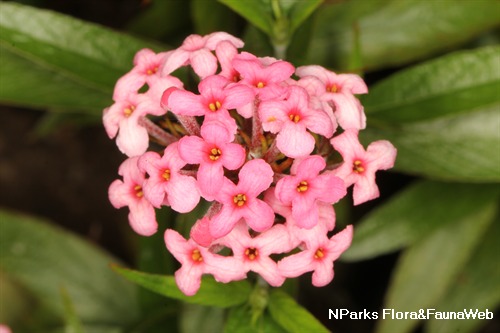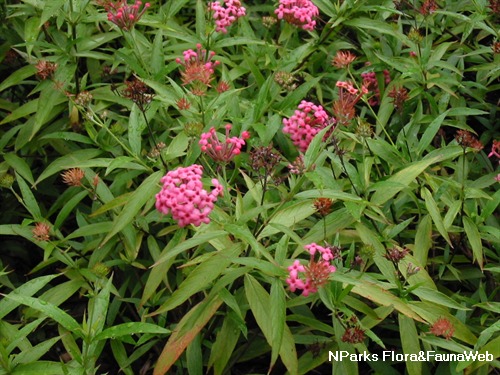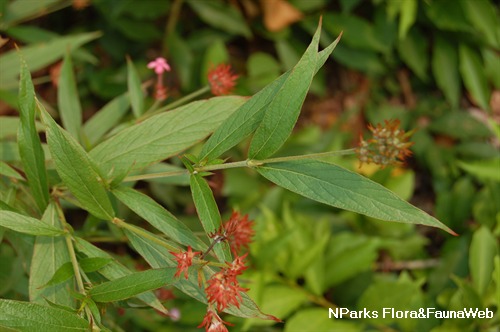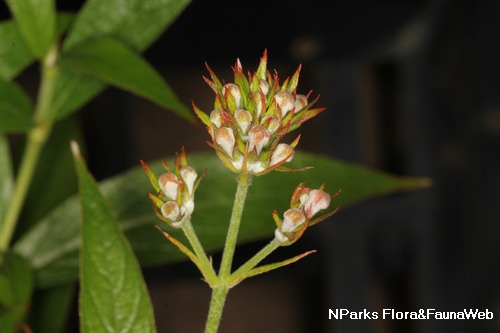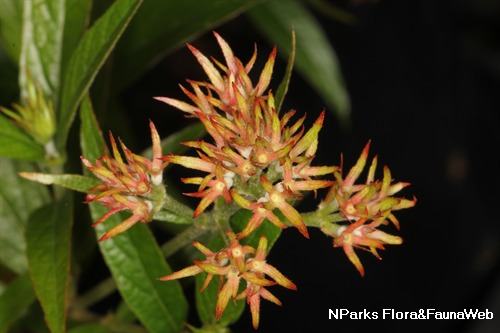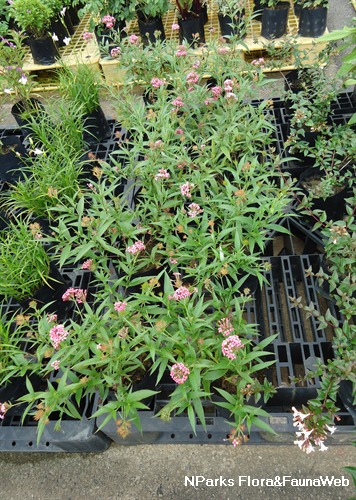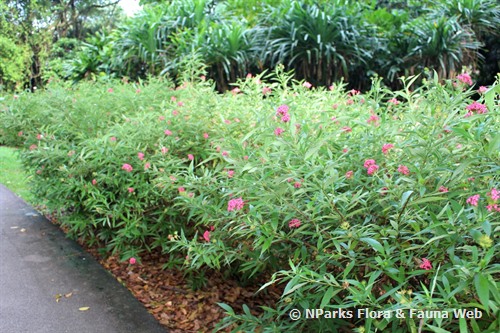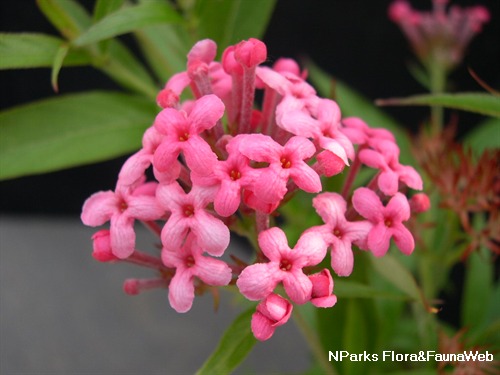
Back
Arachnothryx leucophylla (Kunth) Planch.
| Family Name: | Rubiaceae |
| Synonyms: | Hedyotis leucophylla (Kunth) Spreng., Rondeletia leucophylla Kunth, Arachnothryx elongata (Bartl. ex DC.) Planch., Arachnothryx leptodictya (B.L.Rob.) Borhidi, Arachnothryx yucatanensis (Lundell) Borhidi, Bouvardia discolor Hook. & Arn., Rondeletia dubia Hemsl., Rondeletia elongata Bartl. ex DC., Rondeletia leptodictya B.L.Rob., Rondeletia leucophylla var. calycosa Greenm., Rondeletia yucatanensis Lundell |
| Common Name: | Bush Pentas, Panama Rose, Rondeletia |
Name
Classifications and Characteristics
| Plant Division | Angiosperms (Flowering Seed Plants) (Dicotyledon) |
|---|---|
| Plant Growth Form | Shrub |
| Lifespan (in Singapore) | Perennial |
| Mode of Nutrition | Autotrophic |
| Maximum Height | 1.5 m to 6 m |
Biogeography
| Native Distribution | Mexico to Panama |
|---|---|
| Native Habitat | Terrestrial |
| Preferred Climate Zone | Tropical |
| Local Conservation Status | Non-native |
Description and Ethnobotany
| Growth Form | Woody evergreen shrub with a round shape, typically growing up to 1 - 3 m tall in cultivation but can reach 6 m in the wild. |
|---|---|
| Foliage | Opposite leaves are lanceolate to narrowly ovate (10 - 12 cm long, 2 cm wide). Leaves are sessile (the leaf blade is attached to the stem without an intervening stalk). The upper leaf surface is dark green and hairless, while the lower side is whitish and pubescent (covered in short, white hairs). A forked flap of tissue known as a stipule occurs between the pair of leaves found at each point along the stem. |
| Stems | Woody stem has dark brown, shallowly fissured bark. Young stem is tomentose (covered in soft, short hairs). |
| Flowers | Salverform flowers are tubular with 4 bright pink lobes arranged in the shape of a cross (2 cm long, 1 cm wide). They are arranged in rounded clusters known as cymose inflorescences (5 cm wide). Flowers are most fragrant after sunset. |
| Fruit | Fruits are small, dry and indehiscent, contain many seeds. They are whitish and covered in soft hairs. |
| Cultivation | This species will flower best in full sun or light shade, because deep shade will inhibit flowering and result in leggy plants. Individuals should be spaced 3 - 3.5 m apart. Mulch the plants with compost to prevent the soil from drying out or the roots from overheating. Feed plants with a fertilizer rich in phosphorous to promote flowering. Avoid using nitrogen rich fertilizers, because they encourage development of leaves rather than flowers. Try not to prune this species frequently, because flowers are produced from the new growth. |
| Etymology | The specific epithet "leucophylla" is Latin for white leaf ("leuco" meaning white and "phylla" meaning leaf). The name may be a reference to the pubescent leaves which have short, white hairs. |
Landscaping Features
| Landscaping | This species is planted as an ornamental shrub because of its fragrant, rounded clusters of small, pink flowers. Since its fragrance is strongest after dusk, it would be compatible with other flowering shrubs that are most fragrant during the day, It is ideal for butterfly gardens as a nectar plant. Plant it in the back to avoid obscuring smaller species. |
|---|---|
| Desirable Plant Features | Fragrant (Flowers) (Dawn / Dusk, Day), Ornamental Flowers |
| Landscape Uses | Flowerbed / Border, Parks & Gardens, Small Gardens |
| Thematic Landscaping | Butterfly Garden, Naturalistic Garden, Wildflower Garden |
Fauna, Pollination and Dispersal
| Fauna Pollination Dispersal Associated Fauna | Butterfly-Attracting, Bee-Attracting |
|---|---|
| Pollination Method(s) | Biotic (Fauna) (Insects (Bee), Insects (Butterfly, Moth)) |
| Seed or Spore Dispersal | Abiotic |
Plant Care and Propagation
| Light Preference | Full Sun, Semi-Shade |
|---|---|
| Water Preference | Moderate Water |
| Plant Growth Rate | Moderate |
| Rootzone Tolerance | Fertile Loamy Soils, Well-Drained Soils, Moist Soils |
| Maintenance Requirements | Moderate |
| Propagation Method | Stem Cutting |
Foliar
| Foliage Retention | Evergreen |
|---|---|
| Mature Foliage Colour(s) | Green |
| Mature Foliage Texture(s) | Smooth |
| Foliar Modification | Stipule |
| Foliar Type | Simple / Unifoliate |
| Foliar Arrangement Along Stem | Opposite |
| Foliar Shape(s) | Non-Palm Foliage (Lanceolate) |
| Foliar Venation | Pinnate / Net |
| Foliar Margin | Entire |
| Foliar Apex - Tip | Caudate |
| Foliar Base | Acute |
| Typical Foliar Area | Notophyll ( 20.25cm2 - 45 cm2 ) |
| Leaf Area Index (LAI) for Green Plot Ratio | 4.5 (Shrub & Groundcover - Dicot) |
Floral (Angiosperm)
| Flower & Plant Sexuality | Bisexual Flowers |
| Flower Colour(s) | Pink |
|---|---|
| Flower Grouping | Cluster / Inflorescence |
| Flower Location | Axillary |
| Flower Symmetry | Radial |
| Individual Flower Shape | Salverform |
| Ovary Position | Inferior / Epipgynous |
| Flowering Habit | Polycarpic |
Fruit, Seed and Spore
| Mature Fruit Colour(s) | White |
|---|---|
| Fruit Classification | Simple Fruit |
| Fruit Type | Indehiscent Dry Fruit |
| Seed Quantity Per Fruit | Numerous (>20) |
Image Repository
Others
| Master ID | 1098 |
|---|---|
| Species ID | 2391 |
| Flora Disclaimer | The information in this website has been compiled from reliable sources, such as reference works on medicinal plants. It is not a substitute for medical advice or treatment and NParks does not purport to provide any medical advice. Readers should always consult his/her physician before using or consuming a plant for medicinal purposes. |

